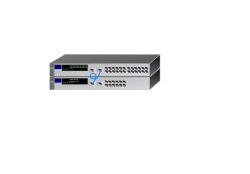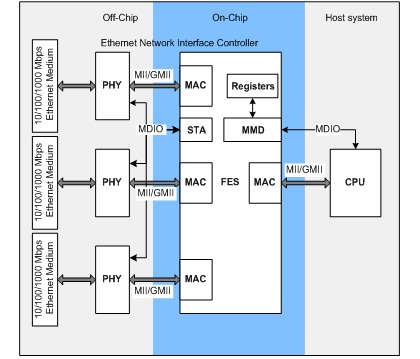Ethernet switches are the ubiquitous building block of any intelligent network. Ethernet technology is deployed in virtually every organization’s data center. Wide Area Networking (WAN) and Metropolitan Area Networking (MAN) providers need to provide their customers with Ethernet services. Ethernet has also become the de facto networking technology in industrial automation even in mission-critical local networks. Modern Ethernet switches have added significant new functionality to Ethernet while decreasing port prices.

FPGA-based Ethernet switches for real-time applications article tells that Lattice Semiconductor and Flexibilis have released a Gigabit Ethernet Switch IP core that is scalable, non-blocking, and extensible. The article also discusses on different Ethernet applications and requirements they need. Article tells about deterministic and synchronized real-time operation, IEEE-1588-2008 (v2) Precision Timing Protocol, redundancy, High-Availability Seamless Redundancy (IEC 62439-3) and how FPGA implementation works for those.

15 Comments
tomi says:
Firefox can restore all windows and tabs that were open when it was last closed or terminated unexpectedly. This article describes the circumstances under which Firefox will restore your previous session and how you can configure it.
http://support.mozilla.com/en-US/kb/Session%20Restore
Specifically look at this tip:
http://support.mozilla.com/en-US/kb/Session%20Restore#w_when-youve-set-firefox-to-show-your-windows-and-tabs-from-last-time
Tomi Engdahl says:
Cloud may have $1B impact on Ethernet
http://www.eetimes.com/electronics-news/4230580/Cloud-may-have–1B-impact-on-Ethernet?Ecosystem=communications-design
The Ethernet switch market is undergoing a technological transformation in the data center as virtualization changes where and how applications are connected to end users. New network topologies are driving entirely new switching platforms.
The evolution towards 10 GE and large data centers is an opportunity. Vendors that understand and embrace the technology change of virtualized data centers running at 10 GE or higher speeds have the opportunity to see their share of IT dollars increase and improve their market position in the next several years.
Tomi Engdahl says:
Rockwell: Ethernet’s Momentum in Automation Is Unstoppable
http://www.designnews.com/author.asp?section_id=1395&doc_id=235887
Ethernet’s move to the industrial automation space is gaining momentum, as engineers make the conversion from the fieldbuses of the 1990s to networks that unify the front office and factory floor.
At Rockwell Automation’s Automation Fair in Chicago recently, engineers said that machine builders are increasingly adopting an open industrial network called EtherNet/IP, despite having spent years learning such automation protocols as DeviceNet, Profibus, ControlNet, SERCOS, SDS, and CANOpen, among others. Moreover, new factories built by manufacturing giants such as General Motors are opting for Ethernet because of its dominance in the IT world.
“The original implementations of Ethernet didn’t have the determinism that you need on the shop floor. But today, Ethernet is replacing the fieldbuses.”
Migration toward Ethernet also appears to be opening up opportunities for Cisco, which says that its industrial business is now growing at 50 percent annually.
Engineers at the show said the biggest draw for major manufacturers is the ability to tie their Ethernet-based IT systems to the shop floor.
Tomi Engdahl says:
Using FPGAs to solve challenges in industrial applications
http://www.eetimes.com/design/programmable-logic/4230820/Using-FPGAs-to-solve-challenges-in-industrial-applications
owever, as Ethernet matures in enterprise architecture, many real-time Ethernet protocols are introduced to the industrial market to provide deterministic communication over reliability and safety concerns.
Because of its increased performance and great cost saving in cables, many of the field bus communications are becoming Ethernet based. It is estimated that by 2014, there will be more Ethernet-based nodes compared to the number of legacy protocols.
To achieve the real time, low latency and deterministic nature required for Industrial use, many of these Ethernet protocols use specialized Ethernet Media Access Control (Ethernet MAC). This is achieved using hardware acceleration and special data packaging for high-speed encoding and decoding. As a result, users can choose either hardened ASICs or FPGAs for implementation. Some protocols are not offered in ASICs, such as Powerlink and sercos III, making FPGAs the only viable solution.
Tomi Engdahl says:
Transfer from FPGAs for prototype to ASICs for production
http://www.eetimes.com/design/military-aerospace-design/4230931/Transfer-from-FPGAs-for-prototype-to-ASICs-for-production?Ecosystem=communications-design
Field-programmable gate arrays (FPGAs) are a valuable technology for designing and prototyping digital logic into today’s applications.
Designing a new product in an FPGA allows for design modifications to be made quickly in hardware.
However, high FPGA unit cost can sometimes prohibit higher volume production. Several alternatives exist for transferring a digital design, implemented with an FPGA, into higher-volume production.
Low-cost solutions such as structured application-specific integrated circuits (ASICs), cell-based ICs, and gate arrays offer higher performance, lower power consumption, higher levels of integration, and better response to radiation effects.
The low non-recurring engineering (NRE) charges associated with a mid-range ASIC solution coupled with a much lower unit price point make this strategy a powerful tool in achieving low overall expense.
Tomi Engdahl says:
Tips and Tricks –Honing Ethernet for new prioritization, timing duties using the Vitesse Serval switch
http://www.eetimes.com/design/communications-design/4233571/Tips-and-Tricks–Honing-Ethernet-for-new-prioritization–timing-duties-using-the-Vitesse-Serval-switch?Ecosystem=communications-design
When Ethernet switches first were employed in the telco central office, existing Layer 2/Layer 3 switches for the LAN were simply scaled up to offer more ports and faster speeds per port, and in many cases that worked just fine. But the development of new standards for packet prioritization and fault resilience, the product of such organizations as IEEE, Internet Engineering Task Force, and Metro Ethernet Forum, has tasked the network-interface OEM with new requirements for service-aware support at the network demarcation point.
By relying on Ethernet as the underlying common Layer 2 protocol, service providers not only flatten their own networks, but also allow their customers to enable unified services across multiple operators. One access device thus can link with many operators.
New generations of switch, MAC, and physical-layer chips for Ethernet, such as Vitesse Semiconductor Corp.’s Serval switch, address the new QoS and timing demands. Serval integrates a MIPS processor to support advanced features such as multiple packet queuing policies, and has an on-board ternary CAM memory to aid in Layer 3 classification. As a result the switch can support any combination of MPLS, MPLS-TP, and traditional bridging.
Network timing is critically important at the edge of the network, for insuring consistent and accurate SLAs. Serval supports 1588v2
Horacio Nimick says:
I merely was given a brand new iPhone and i am pretty pleased. I am seeking to locate and set up all form of superb applications and helpful programs.
Ethernet trends « Tomi Engdahl’s ePanorama blog says:
[...] As Ethernet displaces proprietary field buses to facilitate the operation of the digital factory. Ethernet switches are the ubiquitous building block of any intelligent network. Ethernet has also become the de facto networking technology in industrial automation even in [...]
Tazman says:
As every time cosmic level of writing. Great wishes from a Juniper maniac. Good materials. Very creative blog. Congratulations. Give us more inspirations in the coming weeks.
Tear-Down of an HP ProCurve 2824 Ethernet Switch « Tomi Engdahl’s ePanorama blog says:
[...] on technology in inside Ethernet switch check also my ethernet switch related blog postings. My FPGA-based Ethernet switches posting had an Ethernet switch block diagram that seems to match quite closely to the circuit board [...]
GLC-SX-MM says:
Useful post! Actually been having a look all around for a long time for some-thing like this. From where did you access the expertise originally from? Can you upload a few more websites for additional research. GLC-SX-MM http://www.netwerking.co.uk/GLC-SX-MM-CISCO-OEM
tomi says:
I have been designing all kinds of networking equipment many years. Including systems that have used FPGA in then.
Then I have followed the field quite much. Lots of my experience comes from that…
10G FPGA NIC says:
We delivers near wire speed performance for small and full size packets at 10G FPGA NIC, 10gbe Ethernet, 10gbe fiber nic and 40G MAC, Ultra Low-Latency rate.
toggle switch says:
I have a notable synthetic eye regarding fine detail and can foresee difficulties just before they will happen.
die casting America says:
Whats up! I just would like to give a huge thumbs up for the good info you